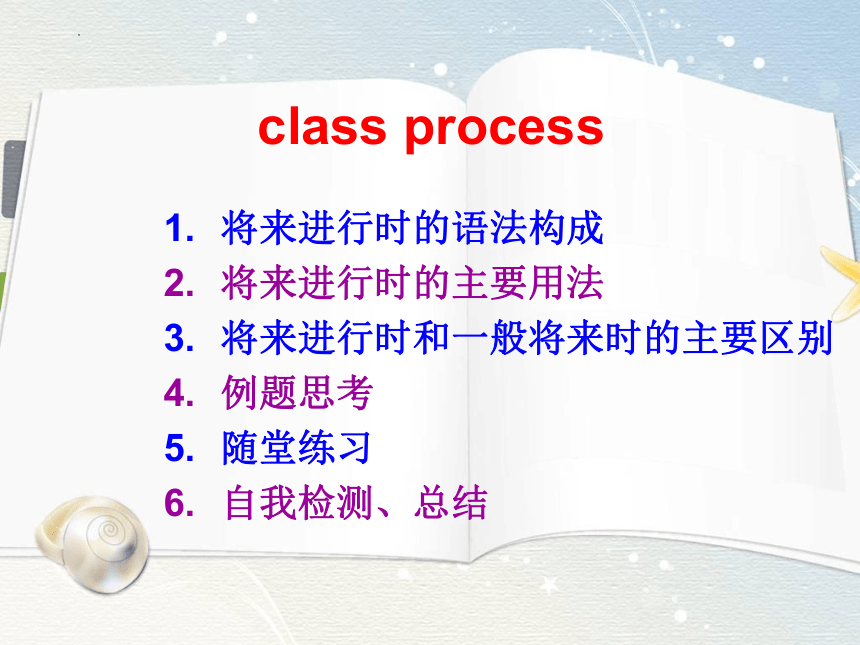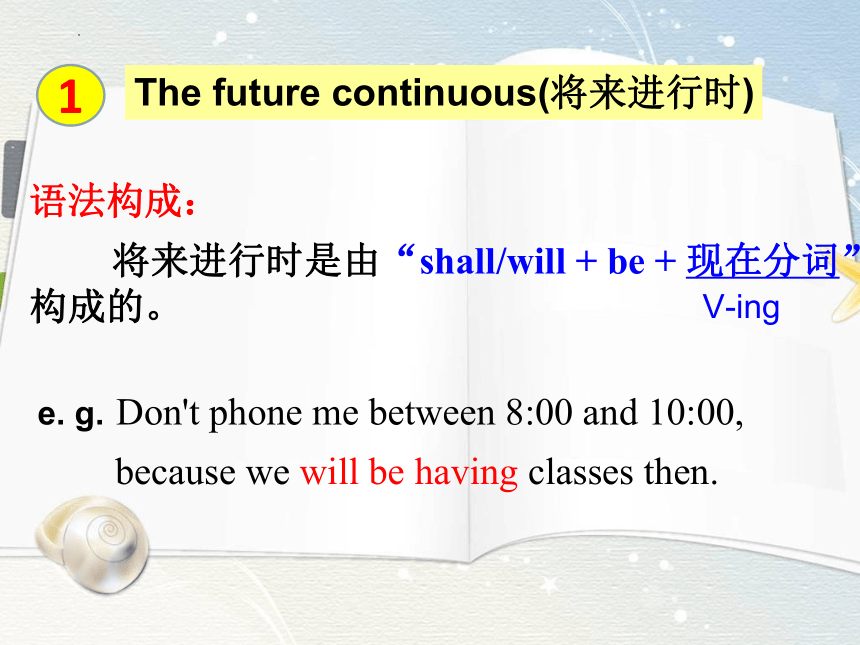外研版 必修四Module 1 Life in the Future Grammar 将来进行时课件(21张)
文档属性
| 名称 | 外研版 必修四Module 1 Life in the Future Grammar 将来进行时课件(21张) |  | |
| 格式 | zip | ||
| 文件大小 | 717.1KB | ||
| 资源类型 | 教案 | ||
| 版本资源 | 外研版 | ||
| 科目 | 英语 | ||
| 更新时间 | 2022-09-13 17:14:54 | ||
图片预览









文档简介
(共21张PPT)
Module 1
Life in the future
Grammar
The future continuous(将来进行时)
四川省眉山中学校 谢明威
I won't be hesitating about my life when I get up tomorrow.
The future continuous(将来进行时)
class process
将来进行时的语法构成
将来进行时的主要用法
将来进行时和一般将来时的主要区别
例题思考
随堂练习
自我检测、总结
语法构成:
将来进行时是由“shall/will + be + 现在分词”构成的。
e. g. Don't phone me between 8:00 and 10:00,
because we will be having classes then.
The future continuous(将来进行时)
1
V-ing
1、表示在将来某一时间点正在进行或在将来某一时间段持续发生的动作。
1)Toby will be climbing in Himalayas
all next week.
2)Will you be working out at the gym
at this time tomorrow
将来进行时主要用法
e. g.
在整个下周,Toby都会一直攀登喜马拉雅山
明天的这个时候,你会在体育馆里锻炼吗?
(时间段→持续)
(时间点→正在进行)
2
2、表示预定的动作或情况,或对将来的安排。
We'll be having tea after dinner as usual.
像往常一样,我们晚饭后将要喝茶。
I’ll be taking my holidays soon.
我很快就要去度假了。
3. 表示某种可能和推测,有表达者表示“我料想,我估计” 的含义。
She will be telling you about the truth
tonight.
她今晚就会告诉你真相。
Be careful or you will be making a
mistake.
仔细一点,否则你会出错的。
4、对别人或对方将来的计划、打算进行礼貌的询问或委婉的请求。
e. g. Will you be having supper with us this evening
今晚你要和我们共进晚餐吗?
Will you be visiting your uncle in Hong Kong
Will you visit your uncle in Hong Kong
With your partners, compare these two examples and try to get the differences between the future continuous and the simple future. Then fill in correct information in your paper.
Group
task
两者基本用法不同:
将来进行时表示将来某时正在进行或持续发生的动作;一般将来时仅表示将来有某事发生,不强调动作持续或正在进行。如:
What will you be doing this time tomorrow
明天这个时刻你会正在做什么事呢?
What will you do tomorrow
明天你要干什么?
将来进行时与一般将来时的区别
3
2. 两者均可表示将来,但用将来进行时
语气更委婉、客气,比较:
When will you finish these letters
你什么时候处理完这些信件?(直接询
问,如上司对下属)
When will you be seeing Mr White
你什么时候见怀特先生?(委婉地询
问,如下属对上司)
3. 有时一般将来时中的will含有“愿意”的
意思,而用将来进行时则只是单纯地
谈未来情况。如:
Mary won’t pay this bill.
玛丽不肯付这笔钱。(表意愿)
Mary won’t be paying this bill.
不会由玛丽来付钱。(单纯谈未来情况)
We an English class tomorrow morning.(have)
We an English class at 8:20 tomorrow morning .(have)
Toby in the Himalayas next Tuesday. (climb)
Toby in the Himalayas all next week. (climb)
will climb
will be climbing
will have
will be having
practice
例题思考
4
1.—— Guess what, we’ve got our visas for a
short-term visit to Hong Kong this summer.
—— How nice! You a different culture then.
A. will be experiencing
B. have experienced
C. have been experiencing
D. will have experienced
解析: then 指代上文当中的时间状语 this summer ,两者均为将来的一段时间。此句用将来进行时为强调在今年夏天期间(即:将来时间段),说话者预测对方将去进行体验不同文化这一持续的动作。
A
2. — Could you give these books to Mr. Black
— Absolutely, ____him at five o’clock this
afternoon.”
A.I will have a talk
B.I have a talk with
C.I can have a talk with
D.I will be having a talk with
解析: 将来进行时在口语中常常用来表示预计即将发生或势必发生的动作,在此处表示将来某一刻的计划、安排。
D
A:Multiple choices
1. At this time tomorrow _______ over the
Atlantic by air.
A. we’re going to fly B. we’ll be flying
C. we’ll fly D. we’re to fly
2. Send for a doctor quickly, or the old man___.
A. will die B. is dying
C. will be dying D. died
A
B
5
3. If you plant watermelon seeds in the spring,
you ____fresh watermelon in the fall.
A. eat B. would eat
C. have eaten D. will be eating
4. You should be patient about the noise, because the workers_____ the broken tubes until next Monday.
A. will repair B. were repairing
C. will be repairing D. are repairing
D
C
Practice
1.今天下午三点到四点, 我们要开会。
We will be having a meeting from 3 to 4 this afternoon.
2.我想他马上就会到的。
I believe he’ll be coming soon.
3.今天下午我要去送一个朋友。
I will be seeing a friend off this afternoon.
4.我不知道我们什么时候再在一起工作。
I don’t know when we will be working together again.
B: Translate the following sentences
into English.
Sorting & Conclusion
6
Work with your partners to
conclude the different usage of 7
time tenses that you have learnt,
and fill in the following chart .
时态 基本形式 基本用法 特殊用法
一般现在 do /does
一般过去 did
一般将来 will do
现在进行 am/is doing
将来进行 will be doing
现在完成 have/has done
过去完成 had done
Do the exercises about the future continuous on Page 6&7 in the textbook and Page 67 in the workbook.
2. Continue to finish the tense table
Module 1
Life in the future
Grammar
The future continuous(将来进行时)
四川省眉山中学校 谢明威
I won't be hesitating about my life when I get up tomorrow.
The future continuous(将来进行时)
class process
将来进行时的语法构成
将来进行时的主要用法
将来进行时和一般将来时的主要区别
例题思考
随堂练习
自我检测、总结
语法构成:
将来进行时是由“shall/will + be + 现在分词”构成的。
e. g. Don't phone me between 8:00 and 10:00,
because we will be having classes then.
The future continuous(将来进行时)
1
V-ing
1、表示在将来某一时间点正在进行或在将来某一时间段持续发生的动作。
1)Toby will be climbing in Himalayas
all next week.
2)Will you be working out at the gym
at this time tomorrow
将来进行时主要用法
e. g.
在整个下周,Toby都会一直攀登喜马拉雅山
明天的这个时候,你会在体育馆里锻炼吗?
(时间段→持续)
(时间点→正在进行)
2
2、表示预定的动作或情况,或对将来的安排。
We'll be having tea after dinner as usual.
像往常一样,我们晚饭后将要喝茶。
I’ll be taking my holidays soon.
我很快就要去度假了。
3. 表示某种可能和推测,有表达者表示“我料想,我估计” 的含义。
She will be telling you about the truth
tonight.
她今晚就会告诉你真相。
Be careful or you will be making a
mistake.
仔细一点,否则你会出错的。
4、对别人或对方将来的计划、打算进行礼貌的询问或委婉的请求。
e. g. Will you be having supper with us this evening
今晚你要和我们共进晚餐吗?
Will you be visiting your uncle in Hong Kong
Will you visit your uncle in Hong Kong
With your partners, compare these two examples and try to get the differences between the future continuous and the simple future. Then fill in correct information in your paper.
Group
task
两者基本用法不同:
将来进行时表示将来某时正在进行或持续发生的动作;一般将来时仅表示将来有某事发生,不强调动作持续或正在进行。如:
What will you be doing this time tomorrow
明天这个时刻你会正在做什么事呢?
What will you do tomorrow
明天你要干什么?
将来进行时与一般将来时的区别
3
2. 两者均可表示将来,但用将来进行时
语气更委婉、客气,比较:
When will you finish these letters
你什么时候处理完这些信件?(直接询
问,如上司对下属)
When will you be seeing Mr White
你什么时候见怀特先生?(委婉地询
问,如下属对上司)
3. 有时一般将来时中的will含有“愿意”的
意思,而用将来进行时则只是单纯地
谈未来情况。如:
Mary won’t pay this bill.
玛丽不肯付这笔钱。(表意愿)
Mary won’t be paying this bill.
不会由玛丽来付钱。(单纯谈未来情况)
We an English class tomorrow morning.(have)
We an English class at 8:20 tomorrow morning .(have)
Toby in the Himalayas next Tuesday. (climb)
Toby in the Himalayas all next week. (climb)
will climb
will be climbing
will have
will be having
practice
例题思考
4
1.—— Guess what, we’ve got our visas for a
short-term visit to Hong Kong this summer.
—— How nice! You a different culture then.
A. will be experiencing
B. have experienced
C. have been experiencing
D. will have experienced
解析: then 指代上文当中的时间状语 this summer ,两者均为将来的一段时间。此句用将来进行时为强调在今年夏天期间(即:将来时间段),说话者预测对方将去进行体验不同文化这一持续的动作。
A
2. — Could you give these books to Mr. Black
— Absolutely, ____him at five o’clock this
afternoon.”
A.I will have a talk
B.I have a talk with
C.I can have a talk with
D.I will be having a talk with
解析: 将来进行时在口语中常常用来表示预计即将发生或势必发生的动作,在此处表示将来某一刻的计划、安排。
D
A:Multiple choices
1. At this time tomorrow _______ over the
Atlantic by air.
A. we’re going to fly B. we’ll be flying
C. we’ll fly D. we’re to fly
2. Send for a doctor quickly, or the old man___.
A. will die B. is dying
C. will be dying D. died
A
B
5
3. If you plant watermelon seeds in the spring,
you ____fresh watermelon in the fall.
A. eat B. would eat
C. have eaten D. will be eating
4. You should be patient about the noise, because the workers_____ the broken tubes until next Monday.
A. will repair B. were repairing
C. will be repairing D. are repairing
D
C
Practice
1.今天下午三点到四点, 我们要开会。
We will be having a meeting from 3 to 4 this afternoon.
2.我想他马上就会到的。
I believe he’ll be coming soon.
3.今天下午我要去送一个朋友。
I will be seeing a friend off this afternoon.
4.我不知道我们什么时候再在一起工作。
I don’t know when we will be working together again.
B: Translate the following sentences
into English.
Sorting & Conclusion
6
Work with your partners to
conclude the different usage of 7
time tenses that you have learnt,
and fill in the following chart .
时态 基本形式 基本用法 特殊用法
一般现在 do /does
一般过去 did
一般将来 will do
现在进行 am/is doing
将来进行 will be doing
现在完成 have/has done
过去完成 had done
Do the exercises about the future continuous on Page 6&7 in the textbook and Page 67 in the workbook.
2. Continue to finish the tense table
